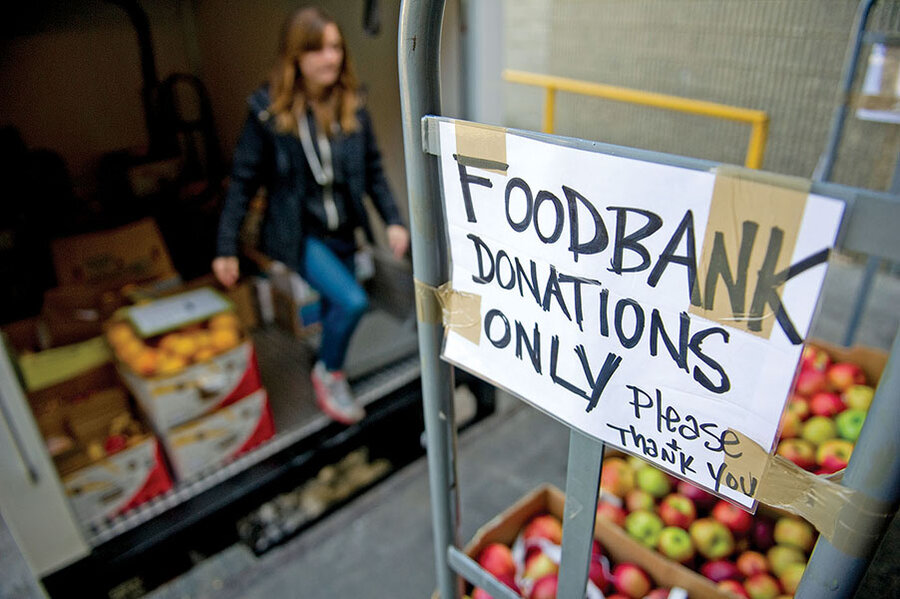World bites into food waste issue
When Kimbal Musk and some fellow business associates hosted a conference on global food waste in 2011, seven people showed up.
So it was noteworthy when, in September, Mr. Musk, a community-focused restaurateur, shared that anecdote at Food Tank’s sold-out summit on food loss and waste in New York City.
“Now we have this extraordinary community that’s listening and working hard on this problem,” Musk told the audience and the more than 70,000 people watching via livestream.
He’s right. The “farm-to-fork” community has ballooned in recent years as the world begins to awaken to the magnitude of the food waste problem. It includes US and international government agencies, corporate producers, sustainability-focused food businesses, college start-ups, data-tracking organizations measuring progress on the issue, and households.
“We are definitely becoming more aware of the pitfalls in our general ‘culture of abundance’ and the tendency of our food system to overproduce,” says Melissa Goodall, associate director of Yale University’s office of sustainability in Connecticut. “That these programs exist and are thriving is an indication that awareness about food waste is rising.”
Annually, the world loses or wastes one-third of all food produced – $3 trillion worth, according to the United Nations. If such waste were a nation, it would be the third-largest greenhouse gas emitter behind China and the United States.
When food is wasted, nobody profits. Businesses lose money, water waste occurs, food goes to landfills, and the world’s hungry miss out. But when it comes to efforts to solve the issue, even “small changes will add up to big impacts,” Gigi Lee Chang, an adviser on food and sustainability, told Food Tank.
In the country that is the world’s biggest waster of food – the US, where retailers and consumers waste 31 percent annually, equal to 133 billion pounds or $161 billion, according to the US Department of Agriculture (USDA) – numerous large and small initiatives are under way.
In 2015, along with the UN, the US committed to a goal of cutting food waste in half by 2030. Within the country, many states have incentivized food donation to the hungry, and the USDA has issued new guidance to standardize food date labels.
At the corporate level, at least 20 major US manufacturers and retailers, including PepsiCo, Campbell Soup Company, Wal-Mart, and Sam’s US, have signed a USDA and Environmental Protection Agency pledge to cut food waste in half by 2030. A consortium of more than 400 more companies has pledged to do the same by 2025.
“When [you] get a critical mass of private business saying that they are going to do this, you know you’ve really started the ball rolling,” says Elise Golan, director for Sustainable Development at the USDA.
Some entrepreneurs are even seeing business opportunities linked to food waste. One of the major contributors to food waste is the amount of blemished but edible food that stores throw away. New start-up company Imperfect Produce, in the San Francisco Bay Area, now delivers the ugly but otherwise consumable goods at a discount.
At the college level, the Food Recovery Network has proved that an idea that starts small can travel far. Founded in 2011 by University of Maryland students, FRN rescues food that would end up in the waste stream and donates it to local food banks and charities. Since then, it has rescued 2 million pounds of food and has 230 chapters in 44 states.
Across the Atlantic, where the European Union estimates it wastes roughly 188 million metric tons (414 billion pounds) annually, hundreds of initiatives have cropped up since 2011. For example, food giant Nestlé is working with farmers to help them increase yields while reducing chemical and water use, Selina Juul, a food waste activist, wrote for the Huffington Post.
At the national level, France has prohibited supermarkets from throwing away food, demanding they compost or donate it instead. Germany has reformed its expiration dates.
In recent years, dozens of so-called zero-waste stores, which sell “ugly vegetables” and where customers fill reusable containers and pay by weight, have cropped up.
“It is only through an end-to-end ‘farm to fork’ approach that we can achieve our targets – and often a local action can create a global impact,” Ms. Juul wrote.





